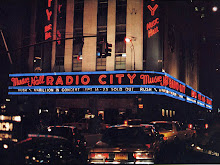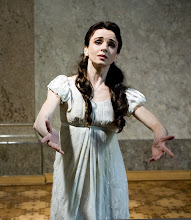 2006 was a big year for travel, and part of it involved venturing across the pond to Italy.
2006 was a big year for travel, and part of it involved venturing across the pond to Italy. While Milan, in northern Italy, represented the gateway in and out of the country; research and advisement revealed that it didn't provide much in the way of tourist attractions...at least not like the other places Italy is known for.
As a matter of fact, Milan was considered rather unfriendly to tourists, as experience would also reveal.
However, like everything else in life, there are exceptions to that notion. While there weren't many attractions in the nation's financial capital, there was still a beautiful Cathedral (the third largest in Europe), the Arcadia (touted as the world's first indoor mall), and a fresco many of you might have heard of called The Last Supper.
 Then, last but not least, there was the La Scala opera house.
Then, last but not least, there was the La Scala opera house. While I'd studied up on a small degree of opera, I had never witnessed one live...so why not start with one -- if not THE -- most revered opera house in the world?
Hey, why not. We're here, aren't we?
La Scala was more about the history and the facility than the opera of that evening; it was about admiring a classic locale that countless operas had been performed in for literally hundreds of years.
The performance that night had lots of variety -- although I couldn't tell you a single word that was sung, as it was all in Italian, of course. The choice that evening was Dido and Aeneas, which blended together a creative balance of singing, acting, and ballet. It had a little bit of everything, which provided a colorful smorgasbord for newbies (yes, my hand is raised).
Our tickets were at the top row, waaaaaaaaaaay in the back, and definitely NOT on the railing, as the view was a bit obstructed. This wasn't like the upper deck of Yankee Stadium, this was the view from the circling blimp above the ballpark (hey, at least we weren't in the HORRIFIC BLIMP SHADOW...uh, inside joke). Needless to say, the quality of sight lines didn't seem to be on the minds of opera house architects and designers hundreds of years ago; at least not for the pobrecitos in the upper deck.
Nevertheless, the opera was enjoyable despite the fact that the story was difficult to follow (I'm not exactly up on my Italian, let alone understanding it while sung at a high octave). The idea of the story was more or less followed through the dancing and acting, which was very interesting and a feast for the eyes.
When the final act ended and the actors/singers took their final bows, I snuck up to the balcony and got a few shots of the massive chandelier that hung down from the high ceiling (see photo above).
I'll leave you with a rather comprehesive history on La Scala, courtesy of wikipedia...come on, get cultured, peeps! You'll learn something new today...and if you're here already, do you really have anything better to do with your time?:
Teatro La Scala
The Teatro alla Scala (or La Scala, as it is known), in Milan, Italy, is one of the world's most famous opera houses. The theatre was inaugurated on 3 August 1778, under the name Nuovo Regio Ducal Teatro alla Scala with Salieri's Europa riconosciuta. La Scala's season traditionally opens on 7 December, Saint Ambrose's Day, the feast day of Milan's patron saint. All performances must end before midnight; long operas start earlier in the evening if need be. Ticketholders are not allowed to enter after the performance has begun.
The La Scala Museum (Museo Teatrale alla Scala), accessible from the theatre's foyer and a part of the house, contains an extraordinary collection of paintings, drafts, statues, costumes, and other documents regarding opera and La Scala's history.
La Scala also hosts the Accademia d’Arti e Mestieri dello Spettacolo (Academy for the Performing Arts). Its goal is to train a new generation of young musicians, technical staff, and dancers (at the Scuola di Ballo del Teatro alla Scala, one of the Academy's divisions).
History
A fire destroyed the previous theatre, the ancient Teatro Ducale, on 25 February 1776, after a carnival gala. A group of ninety wealthy Milanese, who owned palchi (private boxes) in the theatre, wrote to Archduke Ferdinand I of Austria asking for a new theatre and a provisional one to be used while completing the new one. The neoclassical architect Giuseppe Piermarini produced an initial design but it was rejected by Count Firmian (the governor of the then Austrian Lombardy).
A second plan was accepted in 1776 by Empress Maria Theresa. The new theatre was built on the former location of the church of Santa Maria della Scala, from which the theatre gets its name. The church was deconsecrated and demolished, and over a period of two years the theatre was completed by Pietro Marliani, Pietro Nosetti and Antonio and Giuseppe Fe. This theatre had a total over 3,000 seats organized into 678 pit-stalls, arranged in six tiers of boxes above which is the 'loggione' or two galleries. Now the stage is one of the largest in Italy (16.15m d x 20.4m w x 26m h).
Building expenses were covered by the sale of palchi, which were lavishly decorated by their owners, impressing observers such as Stendhal. La Scala (as it soon became to be known) soon became the preeminent meeting place for noble and wealthy Milanese people. In the tradition of the times, the platea (the main floor) had no chairs and spectators watched the shows standing up. The orchestra was in full sight, as the golfo mistico (orchestra pit) had not yet been built.
Above the boxes, La Scala has always had a gallery where the less wealthy can watch the performances. It is called the loggione. The loggione is typically crowded with the most critical opera aficionados, who can be ecstatic or merciless towards singers' perceived successes or failures. La Scala's loggione is considered a baptism of fire in the opera world, and fiascos are long remembered. (One recent incident occurred in 2006 when tenor Roberto Alagna was booed off the stage during a performance of Aïda, forcing an understudy to replace him mid-scene wearing street clothes.) As with most of the theaters at that time, La Scala was also a casino, with gamblers sitting in the foyer.
La Scala was originally illuminated with eighty-four oil lamps mounted on the palcoscenico and another thousand in the rest of theater. To prevent the risks of fire, several rooms were filled with hundreds of water buckets. In time, oil lamps were replaced by gas lamps, these in turn were replaced by electric lights in 1883.
The original structure was renovated in 1907, when it was given its current layout with 2,800 seats. In 1943, during WWII, La Scala was severely damaged by bombing. It was rebuilt and reopened on 11 May 1946, with a memorable concert conducted by Arturo Toscanini, with a soprano solo by Renata Tebaldi, which created a sensation.
La Scala hosted the prima (first production) of many famous operas, and had a special relationship with Giuseppe Verdi. For several years, however, Verdi did not allow his work to be played here, as some of his music had been modified (he said "corrupted") by the orchestra. This dispute originated in a disagreement over the production of his Giovanna d'Arco in 1845; however the composer later conducted his Requiem there on 25 May 1874, and in 1886 announced that La Scala would host the premiere of his opera Otello.[1] The premiere of his last opera, Falstaff was also given in the theatre.
In 1982, the Filarmonica della Scala was established, drawing its members from the larger pool of musicians that comprise the Orchestra della Scala.
Major rennovation 2002-2004Following the traditional 7 December 2001 season opening performances of Otello, which ran through December, the theatre was closed for renovation[2] and, from 19 January 2002 to November 2004, the opera company was transferred to the new Teatro degli Arcimboldi, built in the Pirelli-Bicocca industrial area 4.5 miles from the city centre.
The renovation by the renowned architect Mario Botta proved controversial, as preservationists feared that historic details would be lost; however, the opera company was said to be impressed with improvements to the structure and the sound quality, which was enhanced when the heavy red carpets in the hall were removed. The stage was entirely re-constructed, and an enlarged backstage will allow more sets to be stored, permitting more productions, and the seats now include monitors for the electronic libretto system, allowing audiences to follow opera libretti in English and Italian in addition to the original language.
Conducted by Riccardo Muti, the opera house re-opened on 7 December 2004 with a production of Salieri's Europa riconosciuta, the opera which was performed at La Scala's inauguration in 1778. [3]. Tickets for the re-opening fetched up to €2,000. The renovations cost a reported €61 million, and left a budget shortfall that the opera house did not overcome until 2006.[4]





















No comments:
Post a Comment